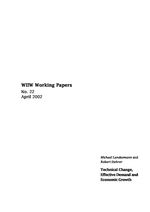Technical Change, Effective Demand and Economic Growth
The model developed in this paper has distinctly classical, but also Schumpeterian and Keynesian features. The main analysis is explored in an aggregate (one goods) setting, but many of the results carry over to a multi-sectoral setting. Sections 2 and 3 present the main components of the model in its equilibrium setting. Here we show the classical wage-profits and consumption vs. investment/growth trade-offs. We also show the conditions which have to be satisfied for full employment growth. Important are distributive requirements - particularly the determination of the real wage - which allow the economy to achieve full employment in the face of (positive) productivity shocks and changes in the available labour force. This issue is further explored in section 4 in the context of changing (exogenous) growth rates of productivity and the labour force. Real wage adjustments are also required if the economy is to remain on a full employment path and profit-receivers change their behaviour with respect to investment vs. consumption spending. Section 5 moves to discuss off-steady state analysis and introduces further components into the model. In 'disequilibrium' there is no immediate price-to-cost adjustment; thus Schumpeterian rents emerge and we allow for some bargaining between workers and capitalists over these rents. In the wage equation features also the impact of the unemployment rate. Hence, as the economy absorbs a (positive) productivity shock, there is a shift of income shares towards 'rents', and different distributive scenarios of such rents can emerge. The next important ingredient to understand the growth implications is to look at the 'spending' pattern out of these rents: these can go into consumption spending, investment spending or they 'leak out' of the real system (e.g. into liquid or financial assets). We show that the classical results obtained earlier with regard to wage-profit consumption-growth trade-offs can be seriously modified when such 'off-equilibrium' dynamics are explored. Here, both Schumpeterian and Keynesian features emerge. Section 6 models the interaction between the financial and the real sector of the economy. We show that the financial sector can contribute through 'leakages' to a fall in output growth (Keynesian perspective) or contributes positively to growth through the pre-financing of investment (Schumpeterian perspective). In simulations we also introduce an 'endogenous growth' element into our model. One of the motivations behind the study is to arrive at an understanding of the so-called 'Solow Paradox', i.e. that there might be evidence of a strong positive technology boost which, however, does not translate - at least for some time - into higher economic growth.
Keywords: technical change, effective demand, economic growth, distribution, classical and Schumpeterian dynamics, technological rents, endogenous growth, dynamic economic modelling
JEL classification: E11, E12, O40, O41
Countries covered: non specific
Research Areas: Macroeconomic Analysis and Policy
